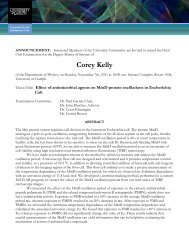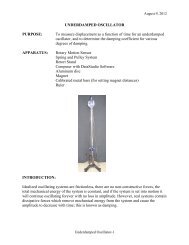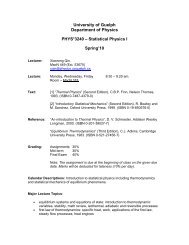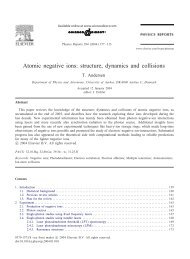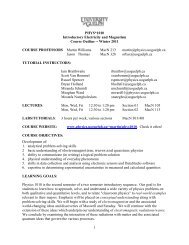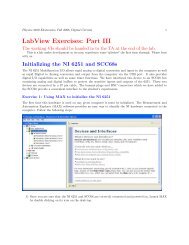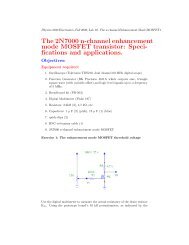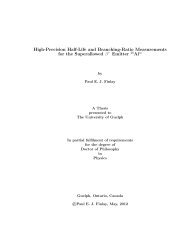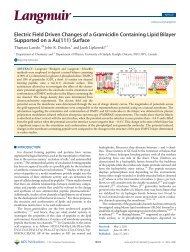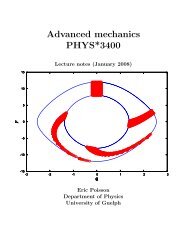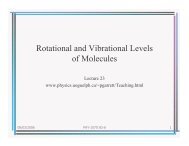Geant4 Simulations for the Radon Electric Dipole Moment Search at
Geant4 Simulations for the Radon Electric Dipole Moment Search at
Geant4 Simulations for the Radon Electric Dipole Moment Search at
Create successful ePaper yourself
Turn your PDF publications into a flip-book with our unique Google optimized e-Paper software.
energy levels are separ<strong>at</strong>ed according to <strong>the</strong> value of J. The 5s orbital does not split,<br />
as shown in Figure 2.4, since l = 0. The energy difference between <strong>the</strong> 2 S 1/2 and<br />
2 P 1/2 levels coresponds roughly to a 794.8 nm wavelength and is called <strong>the</strong> D 1 line.<br />
The D 2 line coresponds to <strong>the</strong> energy difference between <strong>the</strong> 2 S 1/2 and 2 P 3/2 levels<br />
and has a wavelength of about 780 nm.<br />
The next correction to H o is due to <strong>the</strong> interaction between <strong>the</strong> magnetic moment<br />
of <strong>the</strong> electron and <strong>the</strong> nuclear magnetic moment. These splittings are called <strong>the</strong><br />
hyperfine structure and are given by <strong>the</strong> following Hamiltonian,<br />
H hf = Ze2 g N 1<br />
2mM N c 2 4π S·[−I∇ 21 ]<br />
r +∇(I·∇)1 , (2.7)<br />
r<br />
where g N is <strong>the</strong> nuclear g-factor. These levels split according to <strong>the</strong> total angular<br />
momentum F. 85 Rb has a nuclear spin of I = 5/2, thus <strong>the</strong> allowed values of F are<br />
5/2−1/2 = 2 and 5/2+1/2 = 3, as shown in Figure 2.4. These splittings are on <strong>the</strong><br />
order of 10 −6 eV.<br />
The final splitting is due to <strong>the</strong> Zeeman effect, also shown in <strong>the</strong> above simplified<br />
example. The splitting occurs in <strong>the</strong> presence of a weak external magnetic field (B).<br />
Classically, <strong>the</strong> magnetic moment of a particle with charge q and angular momentum<br />
L is given by,<br />
µ = q<br />
2mc L . (2.8)<br />
Extending this result into quantum mechanics, <strong>the</strong> magnetic moment due to <strong>the</strong> total<br />
electronic angular momentum is given by,<br />
µ J = −g J<br />
e<br />
2mc J , (2.9)<br />
and <strong>the</strong> magnetic moment of <strong>the</strong> <strong>at</strong>om is given by,<br />
µ F = −g F<br />
e<br />
2mc F , (2.10)<br />
21



